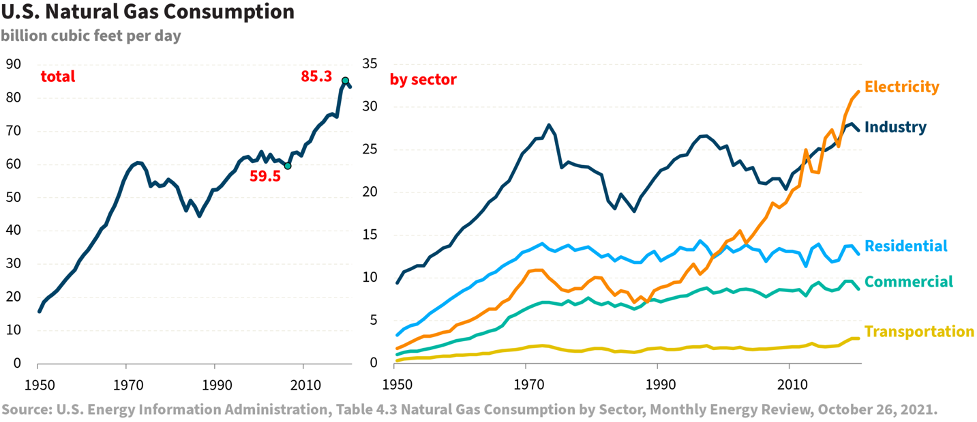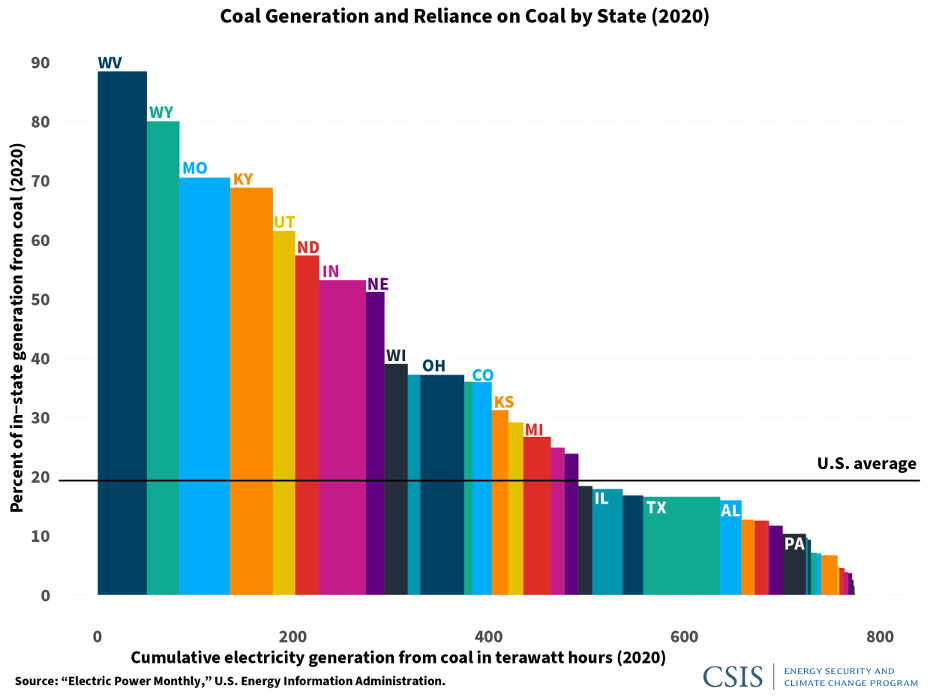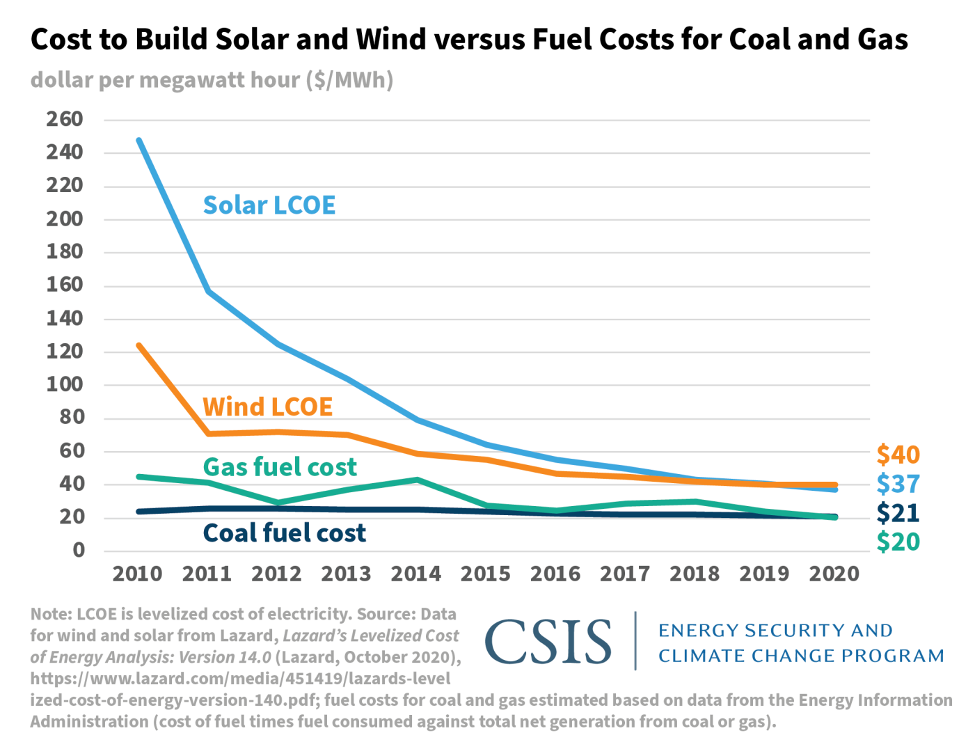RNRF Round Table: Natural Gas and the U.S. Energy Transition

Nikos Tsafos, James R. Schlesinger Chair in Energy and Geopolitics with the Energy Security and Climate Change Program at the Center for Strategic and International Studies (CSIS), spoke at the RNRF Washington Round Table on Public Policy on November 15, 2021. He spoke about the role of natural gas in the U.S.’s transition to a clean energy economy.
Tsafos began his presentation with two central facts about the role of natural gas in the U.S.’s energy transition. First, the United States has a large supply of natural gas which is very cheap to produce. Second, to reach net-zero emissions and accomplish its Paris Agreement goals, the U.S. will have to either eliminate gas use altogether or, at least, eliminate carbon emissions from gas. Either of these tasks will be very difficult to accomplish.
Background
Total natural gas production and consumption in the United States has risen considerably in the past fifteen years. Most of the growth in production has been the result of new innovations like horizontal drilling and hydraulic fracturing making production much cheaper. As production has increased, domestic gas prices have fallen and have become consistently lower than prices in the rest of the world. Lower prices have helped drive an accompanying rise in consumption, driven mostly by an increase in gas use for electricity generation. However, consumption in the industrial sector has also increased significantly, and residential gas use remains very stable. In this time frame, the U.S. has also become a net exporter of natural gas for the first time – it has grown to supply 20% of the global market for liquified natural gas (LNG).
Tsafos emphasized that the future of gas is not just the future of its role in electricity generation. A common narrative about the energy transition is that, with the expansion of renewables, natural gas will soon no longer be necessary. However, renewables primarily replace gas only in electricity generation, which is only one sector where it is used. It is more difficult to replace gas with renewables in industrial, residential, and commercial applications. For this reason, it is important to talk about gas in sector-specific terms. Tsafos organized the rest of his presentation around discussions of each major sector where natural gas is currently used.
Electricity
In the past 15 years, the U.S. has undergone a huge transformation in its electrical power sector. This has been characterized mainly by a reduction in the use of coal and an increase in the use of natural gas for electricity generation. Wind and solar capacity have also increased, but not as significantly as natural gas. About two-thirds of the reduction in coal-fired electricity generation has been replaced with gas, and the rest was replaced largely by wind and solar.
Figure 1

Environmentally speaking, natural gas, when burned, is superior to coal in terms of both planet-warming carbon emissions and local air pollution. The replacement of coal with natural gas in the energy system in recent years has caused significant emissions reductions. However, gas still emits carbon into the atmosphere when burned, so the reductions that can be achieved through this switch are limited. As Tsafos noted at the beginning of his presentation, to achieve net-zero carbon emissions, gas will have to either be replaced by zero-carbon alternatives or the emissions from gas will have to be eliminated. These are both difficult propositions.
The U.S. is a big country, and nationwide trends are not uniform everywhere. Even though gas and renewables have increased their share of electrical generation capacity on a national level, there are still significant variations in state-level performance. Overall, as a country, the U.S. only produces about 20% of its electricity from coal. However, coal still accounts for more than 50% of generation capacity in eight states. This is an important lesson for the future of natural gas in the U.S.: even if use of a certain energy source is waning nationally, there can still be pockets of heavy use that are difficult to dislodge.
President Biden has set a target for 80% of the U.S.’s electricity generation to be carbon-free by 2030. Tsafos walked through a hypothetical thought exercise to discern what that could mean for natural gas generation this decade. The exercise assumes that coal and petroleum generation will reach zero by 2030 and hydroelectric and nuclear capacity will remain stable. In this situation, the U.S. would have to increase solar and wind capacity by a factor of about 5 and reduce natural gas generation by about half. This would create an energy mix with 80% carbon-free generation and 20% fossil fuel-based generation (all from natural gas), in line with the president’s goal. Due to its cheap price, natural gas generation has replaced coal to a very significant degree in the last 15 years. Now, to achieve climate goals, its use will have to be reduced rapidly over a short timeframe.
In order to precipitate widespread replacement of existing gas generation with renewables, the cost of building a new wind or solar generation facility must be less than the cost of running an existing gas or coal facility. Figure 3 shows the cost of gas and coal fuel compared to the levelized cost of electricity (LCOE) without subsidies for solar and wind. Because of subsidies, solar and wind installations are being constructed despite the levelized cost of new installations still being higher than coal and gas. However, without government support, new renewable installations are currently on average about twice as expensive as continuing to run existing fossil fuel installations. The key question to ask of energy legislation seeking to speed up the energy transition is: are the policy measures envisioned in legislation enough to bring the cost of new solar and wind lower than existing gas? This is a difficult challenge because gas is so cheap, but it is key to the future of the electric power sector.
Figure 2

Figure 3

Industry
In the United States, the industrial sector uses more energy than the commercial, residential, or transportation sectors, and the bulk of its energy comes from natural gas. Certain regional industries use huge amounts of energy – for instance, in 2018, the manufacturing industry in the South alone consumed about 12% of the country’s energy. Half of that was solely from the chemicals industry. In any climate plan, reducing energy use and emissions from the industrial sector is essential.
More than any other source, the energy used in industry comes from gas, and gas’s share of industrial energy use has increased in recent years. Moreover, the majority of equipment used in industrial applications is incapable of switching away from natural gas to another fuel source. In order to conduct a transition away from gas in the industrial sector, new equipment will be necessary in many cases.
Rather than replacing gas-burning equipment, another solution that has been proposed is the adoption of carbon capture utilization and storage (CCUS), which primarily involves capturing carbon before it enters the atmosphere and storing it underground. Currently, there is only a very low level of policy support for this technology, and it remains too expensive to be adopted at scale. Universal adoption of CCUS would require a drastic increase in policy support.
Buildings
A significant portion of the U.S.’s natural gas use is in buildings, where it is primarily used for space heating. There are multiple solutions to reduce reliance on gas in this sector. One is to improve the energy efficiency of buildings. If a building is built more efficiently, it is less prone to its heating or cooling escaping to the outdoors, and therefore will use less energy for temperature control. A widespread effort to retrofit buildings would be necessary to improve building energy efficiency on the necessary scale to meet climate goals, and thus far, the U.S. has still made very little progress in doing so.
The other aspect of building efficiency that Tsafos focused on is the equipment used for space heating. Currently, natural gas accounts for a large portion of energy use for space heating around the world. By 2050, if the world is to accomplish net-zero climate goals, natural gas-fueled space heating must be eliminated. In this scenario, gas would primarily be replaced by heat pumps, which use electricity to heat and cool a building, and these heat pumps would be powered primarily by renewable electricity.
In the U.S., heating, cooling, and ventilation accounts for more than 50% of home energy use. About half of U.S. households rely on natural gas as the primary means of heating their home. If the U.S. is to meet its climate goals, the use of gas to heat buildings will have to be phased out. The current economics of electric heating are not favorable to this happening soon. At the moment, electric heating is still much more expensive on average than heating a building with natural gas. While electric heat pumps are becoming more reliable and affordable with time, policy support will be necessary for an energy transition in the building sector to happen in the immediate future.
Exports
The U.S. is already a large exporter of liquified natural gas (LNG), supplying about 20% of the global market, and more export facilities are still being built and planned (Figure 4). How we think about natural gas and the energy transition in the United States is not entirely a question of domestic consumption. The U.S. also plays a significant role in the global marketplace for natural gas, meeting the consumption needs of other countries. This is an important consideration when thinking about the future of gas production in the U.S.
Figure 4

Methane Leakage
In the Q&A session of the round table, Tsafos addressed the issue of methane leakage from natural gas infrastructure. The role of gas in the energy transition is complicated by the fact that natural gas is primarily composed of methane, which is a greenhouse gas that contributes more to climate heating in the short-term than CO2. Limiting methane emissions is an essential part of addressing climate change. Atmospheric concentrations of methane are rising, but our knowledge of the degree to which different sources are emitting it is limited. Scientific work is being done to determine the sources of methane emissions, so understanding of this issue will improve with time. For now, it is known that natural gas infrastructure contributes to methane leakage, but it is not known exactly how significant a source it is.
Depending on how much methane leaks into the atmosphere during the production and transportation of natural gas, its environmental benefits compared to coal can weaken or, in rare cases, even be eliminated altogether. Any case for the climate benefits of natural gas is undermined if methane leakage is not addressed. The first step in doing so is to invest in better monitoring of methane emissions. Until accurate data on the extent of the problem is available, it will be impossible to solve it effectively. Stronger regulations will also be necessary to incentivize companies to reduce their methane emissions. This is not a particularly expensive undertaking. Often, costs to mitigate leakage are recouped because less gas is being wasted. On a net basis, companies can make money back from this endeavor, but regulation is necessary to ensure that it is actually being done.
Just Transitions for the Natural Gas Sector
In the Q&A session, Tsafos also addressed the issue of just transitions for workers in the natural gas industry in the U.S. If, as he demonstrated in his presentation, natural gas capacity is reduced by 50% this decade to meet climate goals, a lot of people who work in the natural gas sector will lose their jobs. The last energy transition, from coal to natural gas, was not smooth. It occurred very abruptly and little was done to support the people and communities that were impacted by the closure of mines and power plants. It is very difficult to maintain a strong local economy when its major industry disappears. Tsafos identified two key points which can help to smooth the energy transition for communities that currently rely on the gas industry. First, he noted that environmental remediation is necessary – if the remnants of the gas industry are not cleaned up, it can be more difficult to bring other industries in. Second, he noted that the solutions for a just transition are different in different communities. Gas industry jobs lost to the energy transition do not need to be replaced by jobs working with renewables. Regionally focused efforts to find and grow successful institutions and businesses are necessary, and these efforts should be responsive to the needs of the community.
Conclusion
Natural gas will need to be phased out if the United States is to meet its net-zero targets. This will be very difficult to accomplish. In the power sector, gas faces competition, primarily from renewables, but it remains cheap and will be difficult to dislodge without policy support for renewables. In the industrial sector, a net-zero pathway will rely largely on CCUS and/or hydrogen, rather than electrification and renewables. Eliminating gas use from buildings will require a huge turnover in the appliances used, especially for space heating. At this moment, the economics of such a shift are generally still not favorable, depending on location. And, finally, the U.S. is still conducting a huge push to export gas to the rest of the world. The U.S.’s domestic ambitions to reduce gas use must be reconciled with the fact that a lot of other countries are expecting to rely on U.S. gas for their own energy.
– Stephen Yaeger, RNRF Program Manager
To view the PowerPoint associated with Tsafos’s presentation, click here.
